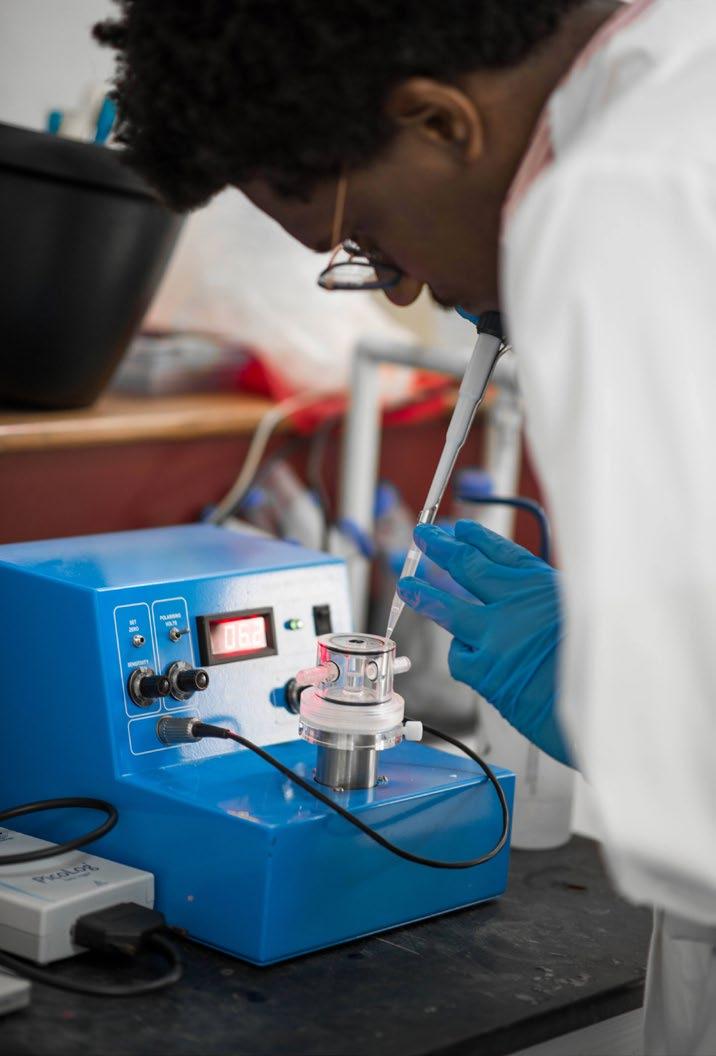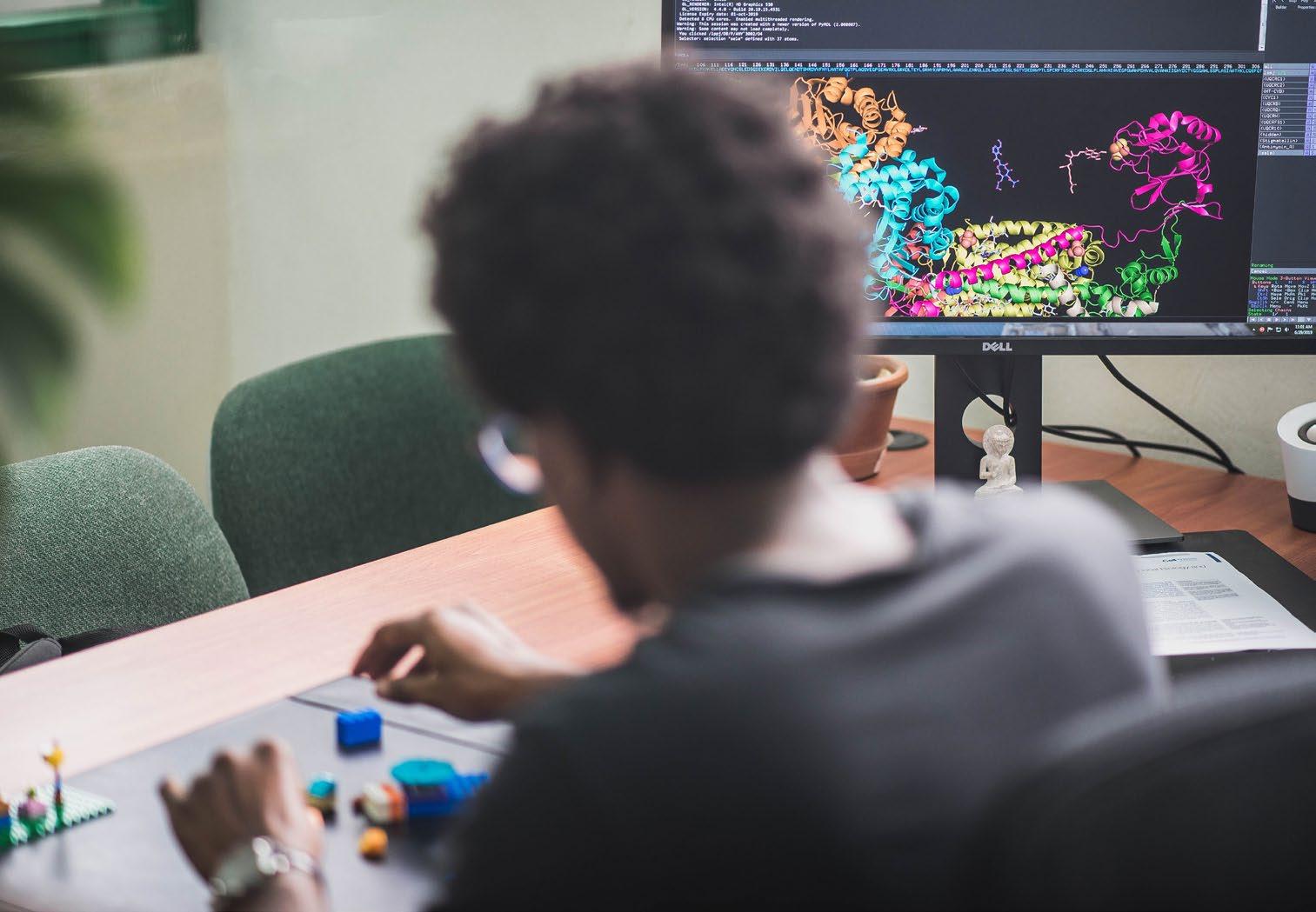
5 minute read
SHANE AUSTIN
BY ALEX EVANS
Shane currently teaches students at all levels of the biochemistry programme at University of the West Indies in Cave Hill, Barbados, as well as coordinating their graduate studies programmes, but Shane didn’t always see himself as a scientist. In fact, Shane actually considered a career in medicine for a while, but, following his undergraduate degree, Shane moved to Montreal for a master’s in one the topics that he found most fascinating— mitochondria. “For my PhD, I wanted a change of geography while still studying mitochondria so I ended up in a lab in Vienna,” he says. “And I have thoroughly enjoyed every minute of being a research scientist.”
Building on this early work, Shane’s research career has primarily focused on mitochondria, investigating its role in metabolism and how it factors into diseases such as cancer. “For cancer biology, I have worked on a number of projects over my career and all have involved mitochondria, which have been demonstrated to have an ever-evolving role in cancer,” he says. “The first project focused on one of the most commonly prescribed diabetic drugs, metformin, which was shown to reduce oxygen consumption in cancer cells, and some of my very early work on this paved the way for further studies to explore this metformin axis of cancer treatment depending on the cell’s metabolic preferences.”
In addition to his contributions to cancer research, Shane has worked extensively on a single transmembrane mitochondrial protein named LETM1. “The gene is essential in humans and mice, but its exact function was still unknown at the time,” he explains. “It was clear based on my experimental evidence and others that it plays a key role in maintaining osmotic balance in mitochondria but there was an open debate as to if it transported calcium out of mitochondria or not.” From the work started during Shane’s PhD, he recently found that LETM1 interacts with a protein responsible for calcium exchange for protons in mitochondria.1 “This finding was a major conceptual leap in mitochondrial biology because this transporter was the focus of much research by scientists in the 1970s,” he says. “The finding really put to rest a long-held debate about LETM1 function because there was a lot of speculation as to the identity of this calcium transporter.”
Shane’s work has benefited our understanding of not only cancer biology, but also other diseases such as the ZIKA virus. While between PhD studies and his current post, Shane got involved with a project to sample mosquitoes in his home country of Barbados to analyse them for ZIKA virus variants and other viruses. This work eventually identified novel ZIKA variants and over 30 new strains of arbovirus, demonstrating how little we still know about the number of viruses that have the potential to infect humans.2 “After the height of the ZIKA outbreak in the Caribbean region, the importance of this work became clear to most people in the region,” Shane explains. “Recently, I have restarted work similar to this, assessing with an undergraduate research student the local mosquito population in both urban and rural habitats and assessing their bloodmeal preferences, which, to date, has not been done locally.”
From his experiences as both a researcher and educator, Shane is an avid believer that improvement and innovation of experimental techniques is crucial to progressing our understanding of diseases such as cancer. “Without the development of new technologies, we won’t have advancement in these areas, our knowledge becomes limited and worst yet, we start to become unaware of some of the ways it is limited,” he says. “A lot of the findings we see in the big journals and hear about in the media simply weren’t possible at this scale two decades ago; the technology and computing power didn’t exist at this scale.”
As well as contributing to contemporary biochemistry research, Shane is also interested in finding new ways that biochemistry can be taught in the classroom. One such way has involved getting students to engage with LEGO. “I started using LEGO bricks in my classroom to explain concepts to my students and I found that they were inexpensive and easy to use. Importantly, they are also automatically associated with fun,” he explains. “However, initially I was the person doing the building and explaining, so to change that, I started adopting LEGO brick use such that students were the ones who did the construction and explanation.” Shane’s new approach encourages the students to build models and describe them in the context of biochemistry, resulting in a more engaging and creative learning process that he recommends other educators give a try. “Students are often engaged, active and talking about content in class, searching for creative ways to demonstrate what would otherwise be abstract and hard-to-visualise biological and thermodynamic concepts,” he says.3 “I encourage anyone willing to try new things to have a go with it in their classroom.”
As a Barbadian, Shane reflects on how fortunate he feels to be able to come home to his country of origin to educate the next generation of biochemists. “Returning to Cave Hill and teaching and doing research with some of the same people that got me into biochemistry and taught me has been a definite highlight,” says Shane. “Coming to that realisation took me some time to fully appreciate the moment for what it is, but it is a unique privilege, and the more I read about various scientists and their career paths, I have been uniquely privileged in this regard.”
When he’s not teaching, Shane’s interests include gardening and reading—especially novels from the postcolonial world such as Nigeria, India and South Africa. “They all have such diverse cultures, and I always end up learning something new about their cultures and countries with each novel,” he says. “And travelling is one aspect of my job that I especially love, because it opens up chances for me to visit some very cool and unique places to communicate science and interface with likeminded scientists.”
When discussing experimental biology, the range of topics involved are incredibly diverse, but can the same be said for the researchers that we recognise and celebrate? “Most scientific awards currently reinforce traditional stereotypes of scientists and, importantly, exclude historically marginalised groups,” explains Shane. “The SEB realised this was also true of its prizes and committed itself to make a difference in this regard.” Recently, Shane
Above Left Shane working in the lab
Above Right Shane using LEGO bricks to demonstrate biochemistry concepts
Photo credit:
Shane Austin and other advocates for inclusion and equality established the SEB Awards Nomination Task Force with the goal of improving the representation of award nominations for people belonging to these historically marginalised groups.
“Currently, we are in preparation for our first round of nominations for the SEB’s 2024 awards,” he says. While the selection of prize winners remains independent of the task force, Shane and his fellow members hope that by identifying more nominees from marginalised groups, they can positively impact a wider group of people that are deserving of recognition. “We are still looking for members to join us, so if you are interested, please reach out to one of the SEB Outreach, Education and Diversity staff members or me,” he concludes. For more information about the SEB Awards Nomination Task Force, including how to apply to become a member or to nominate someone for an award, please visit centenary/awards-nominationtask-force.html.
References:
1. Austin S, Tavakoli M, Pfeiffer C, et al. LETM1-mediated K+ and Na+ homeostasis regulates mitochondrial Ca2+ efflux. Front Physiol 2017; 8: 839.
2. Thannesberger J, Rascovan N, Eisenmann A, et al. Viral metagenomics reveals the presence of novel Zika virus variants in Aedes mosquitoes from Barbados. Parasit Vectors 2021; 14: 343.
3. Austin S, Millar CA, Christmas S. Case study: Perspectives on the use of LEGO® bricks in the biochemistry classroom. Essays Biochem 2022; 66: 53–63.



Caroline Wood caught up with him about his journey so far.










